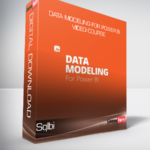Sqlbi – Data Modeling for Power BI Video Course
Original price was: $349.00.$157.00Current price is: $157.00.
The goal of the video course is to teach through examples of increasing complexity how to solve business scenarios…
File Size: 23.0 GB.
- Description
- Reviews (0)
Description
Description
Sqlbi – Data Modeling for Power BI Video Course

Data modeling is a required skill to get the most out of Power BI, Power Pivot for Excel, and Analysis Services. This video course is aimed at users of Power BI Desktop or Power Pivot for Excel, and at Analysis Services developers who want to learn how to build the optimal data model for their reporting needs.
The goal of the video course is to teach through examples of increasing complexity how to solve business scenarios by adapting the data model, so that the required DAX code becomes easier, faster and more robust. All the demos and the exercises are based on Power BI examples. However, the very same concepts can be applied to Power Pivot and Analysis Services Tabular.
The video course is made up of over 10 hours of lectures, plus another estimated 8 hours of individual exercises. You can watch the videos at any time and the system will keep track of your progress. Within the video course you can download the material for all the exercises.
Students have access to a private discussion area where they can interact with the instructors asking questions related to the lectures and the exercises.
Curriculum
- Presentation of Data Modeling for Power BI
- Presentation of Data Modeling for Power BI
FREE
- Exercises, slides, and demos
- How to download and complete exercises
FREE
- Exercises download
- Demos download
- Slides of the video course
- SQL Server Contoso DW database
- Introduction to data modeling
- Introduction to data modeling
FREE
- Introduction
FREE
- Analytical limits
FREE
- Increasing the analytical power
FREE
- Introducing the data model
FREE
- Leveraging the data model
FREE
- Normalization and denormalization
- Facts and dimensions
- Introducing star schemas
- If you don’t have a star schema
- Chains of relationships
- How many dimensions?
- Why data modeling is useful
- LAB number 1
- Header / detail tables
- Header / detail tables
FREE
- Introducing header / detail schemas
- Bidirectional filtering is not the way to go
- Header / detail
- Denormalizing the discount
- Back to a star schema
- LAB number 2
- Multiple fact tables
- Multiple fact tables
FREE
- Using multiple fact tables
- Moving filters with DAX
- Building a star schema
- How to properly use multiple fact tables, if present
- Trying bidirectional filtering
- Model ambiguity
- Solving ambiguity
- LAB number 3
- Working with date and time
- Working with date and time
FREE
- Date attributes in the fact table
FREE
- Building a date dimension
- CALENDARAUTO
- The model with a date dimension
- Automatic date grouping in Excel and Power BI
- Automatic date grouping in Power BI
- Quick calculations in Power BI Desktop
- Disable automatic date columns
- Handling multiple dates
FREE
- Multiple date tables
FREE
- Multiple date tables with multiple fact tables
FREE
- Multiple relationships with date
- Handling date and time
- Computing with working days
- Create a holidays table (one country)
- Create a holidays table (multiple countries)
- Weekends are not always the same
- Handling special periods of the year
- Non-overlapping periods: the model
- Non-overlapping special periods
- Overlapping special periods
- Overlapping period measure
- LAB number 4
- Tracking historical attributes
- Tracking historical attributes
FREE
- Attributes change over time
- Handling variations over time
- Slowly changing attributes or dimensions?
- Rapidly changing dimensions
- Attributes in the fact table
- Using snapshots
- Using snapshots
FREE
- What is a snapshot?
- Sales versus inventory in the same model
- Non-additive measures
- LASTDATE does not work here
- Optimizing performance
- Snapshots and granularity
- Transition matrix
- Parameter table
- LAB number 5
- Analyzing date and time intervals
- Analyzing date and time intervals
FREE
- What are intervals?
- Solving with DAX… too complex!
- Changing granularity
- Split hours AND amount!
- Analyzing active events
- Open orders: the starting model
- Open orders with DAX
- Changing the model
- Open orders is a snapshot table
- Events with different durations
- Daily Salary (DAX)
- Precompute the values
- LAB number 6
- Many-to-many relationships
- Many-to-many relationships
FREE
- What are many-to-many relationships?
- Possible solutions to the scenario
- Bidirectional filtering
- Using CROSSFILTER
- Using expanded table filtering
- CROSSFILTER versus expanded tables
- Understanding non-additivity
- Cascading many-to-many
- Additional material
- LAB number 7
- Working with different granularities
- Working with different granularities
FREE
- Dimensions define granularity
- Analyzing budget data
- Reduce granularity on all the tables
- Using DAX to move the filters
- Filtering through relationships
- Use the correct column to slice
- Leveraging relationships
- Checking granularity in the report
- Hiding or reallocating?
- LAB number 8
- Segmentation data models
- Segmentation data models
FREE
- Segmentation models
FREE
- Static segmentation
FREE
- Static segmentation: the formula
FREE
- Dynamic segmentation
- Dynamic segmentation: the formula
- ABC and Pareto analysis
- Working with multiple currencies
- Working with multiple currencies
FREE
- Using multiple currencies
- Beware of simple calculations
- Multiple sources, one reporting currency
- Conversion with a calculated column
- Single source, multiple reporting currencies
- What the formula should perform
- Multiple sources, multiple reporting currencies
Get Digital Download ” Sqlbi – Data Modeling for Power BI Video Course ” Right Now!




Reviews
There are no reviews yet.